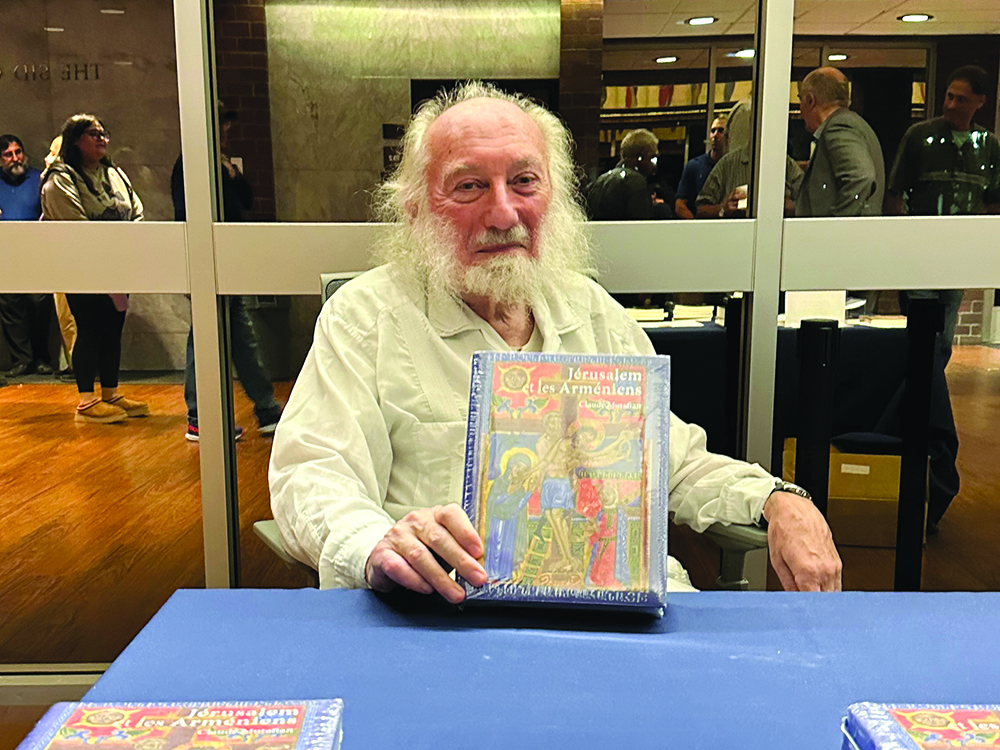
Photo: Natalie Agazarian
Sara Beberian
Staff Writer
Jerusalem: the Holy City. A land that is important to Jews, Christians, and Muslims, and that has been contested for centuries. The period of the Crusades, from the eleventh through the thirteenth centuries, brought different leaders and religious authorities to rule over Jerusalem. However, in the eyes of many, the Armenians presence in the Holy Land has often been overlooked.
Dr. Claude Mutafian’s lecture “Jerusalem and the Armenians until the Ottoman Conquest (1516),” based on his new book Jérusalem et les Arméniens: Jusqu’à la conquête ottomane (1516), presented an overview of the history of Armenians and their impact on Jerusalem to an audience of Fresno State students and community members. Dr. Mutafian, the son of Armenian Genocide survivors, has taught for more than forty years at leading universities around the world including in Paris, in New Jersey, in Havana, in Mexico, and in Yerevan. He traveled from Paris to give a talk organized by the Armenian Studies Program on Tuesday, October 3, 2023, and to speak about his new book, Jérusalem et les Arméniens. The presentation was made possible through the support of the Ralph Kazarian Armenian Memorial Fund.
Written in French, his book highlights the contributions of Armenians to the Old City of Jerusalem and discusses the ties between the Armenians and Jerusalem that have existed for centuries. Dr. Mutafian highlighted the fact that despite the distance between Jerusalem and Armenia, there has always been contact between the two. Throughout history, Armenians have been attracted to the Holy City, as the holiest site in Christianity. The Old City of Jerusalem is divided into four distinct quarters, which include the Christian Quarter, the Jewish Quarter, the Muslim Quarter, and the Armenian Quarter. Dr. Mutafian emphasized that the Armenian Quarter is distinct from the neighboring Christian Quarter.
The Armenian Quarter is the most important repository of Armenian culture outside Armenia. The Quarter includes the Armenian Patriarchate, the Cathedral of St. James, the Gulbenkian Library, and the newly renovated Edward and Helen Mardigian Museum of Armenia Art and History. Dr. Mutafian described the inside of the Armenian Quarter “as if one is inside an Armenian village,” and it is evident that Armenians have been living in Jerusalem for centuries.
The Mardigian Museum exhibit that Dr. Mutafian curated together with Dr. Raymond Kévorkian, contains many examples of Armenian art and Armenian religious artifacts, such as chalices, altar curtains, manuscripts, and other significant religious objects. The St. James Monastery houses the second richest Armenian manuscript library in the world, with a collection of over 4,000 manuscripts.
The presence of Armenians in Jerusalem, however, stretches farther than even the walls of the Armenian Quarter, as the Armenians have possessions in the Church of the Holy Sepulchre, in the Christian Quarter, with their own chapel and altar to celebrate the Divine Liturgy. How did Armenians come to administer all of these sacred areas? Lands that have been fought over for hundreds of years, lands that are considered priceless by the three most important monotheistic religions of the world. Dr. Mutafian explained that the history of Jerusalem and the Armenians dates even to the pre-Christian era. Dr. Mutafian tied each major point in the lecture back to his thesis – that Armenians have always felt an attraction to Jerusalem.
Tigran the Great, in the first century BC, arrived near Jerusalem, and was about to enter the city, but when he learned that the Romans were attacking Armenia, he returned to Armenia. Many of Armenia’s most important figures had dreams of visiting Jerusalem or they visited Jerusalem after accomplishing amazing things in Armenia. For example, St. Gregory the Illuminator went to Jerusalem after converting Armenia to Christianity, and St. Mesrop Mashtots visited Holy Jerusalem after creating the Armenian alphabet in the fifth century.
Dr. Mutafian documented the connections between the Holy Land and the Armenians. He mentioned that the first two queens of Jerusalem were Armenian and that one of the most famous queens of Jerusalem, Melisende, was Armenian and extensively praised in French historiography.
In his illustrated lecture, Dr. Mutafian was able to give an overview of the historical link between the Armenians and Jerusalem, discussing the Crusades and the Armenians, Armenian royalty in Jerusalem, and explaining the many connections between the Armenian people and the Holy City of Jerusalem.
 Hye Sharzhoom Armenian Action
Hye Sharzhoom Armenian Action